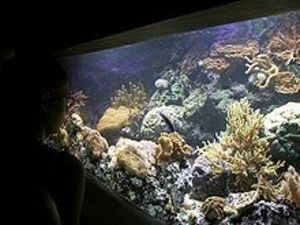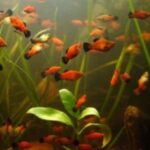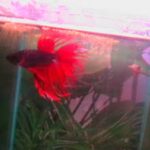Algae are common problems in all kinds of aquariums, including reef or salt-water aquariums. But it is a common misconception that algae need to be completely eliminated in the marine fish tanks. Some algae will always be present in healthy aquarium water, according to “The Everything Aquarium Book” (Adams Media; 2006.)
But algae can quickly grow out of control and fill up the tank, using up oxygen fish, invertebrates and plants need to survive. Just like everything else in life, only a little algae is good. Having a marine tank so full of algae that you cannot see anything else is not. There are many ways to control algae without harming fish, invertebrates or live corals.
Warning
Algae that have become a nuisance should be removed by hand or pruned back to nubs. Never use “algicides” or chemicals sold in pet stores to kill algae because they may also kill any live plants, invertebrates and fish, according to “The Everything Aquarium Book.” It is usually the copper in algae-killing chemical treatments that does the harm to other life forms in the tank.
Types
The most beneficial type of green algae in reef tanks look like seaweed, according to “The Everything Aquarium Book.” Golden brown or a yellowish algae tend to grow very slowly and often does not become a problem in a marine tank, according to aquarist Bob Fenner of Wet Web Media. Red algae and brown algae coats aquarium walls, equipment and decorations in a thick velvet fuzz. Blue-green algae looks like green, black or red slime and should be removed.
Most types of algae have a population explosion when they are exposed to large spikes in their food. Nutrients that feed algae include phosphates and nitrates. Be sure to check your aquarium water to see if there has been a rise in these nutrients. A partial water change can help to quickly reduce these nutrients.
Solution and Prevention
If algae is already a problem in the salt water tank, the safest treatment is to remove the algae by hand. Scrape off algae from walls and decorations with an algae scraper just used for that tank. Immediately sucking up the algae-laden water with a siphon hose and replace with water treated with aquarium salt.
Prevent algae overgrowth with the use of a protein skimmer. Make sure the tank has bright lighting, as algae can grow in dim lighting, except for yellowish algae. Less light can curb the growth for that type.
There are also many salt water creatures that love to eat algae. They may be so efficient that you may have to feed them commercial algae wafers in order to keep them fed. These creatures include turbo snails, sea urchins, sea hares, hermit crabs and even dwarf angelfish, which prefer green algae to any other kind. Just be sure not to overcrowd the tank and research the species to be sure the new critter will get along with all of the other critters in the tank.
References:
“The Everything Aquarium Book.” Frank Indiviglio. Adams Media; 2006.
Fish Channel. “Aquarium Marine Algae.” http://www.fishchannel.com/fish-health/saltwater-conditions/aquarium-marine-algae.aspx
Fish Lore. “Aquarium Algae Control.” http://www.fishlore.com/aquarium-algae-control.htm
Wet Web Media. “Algae and Their Control in Marine Systems.” Bob Fenner. http://www.wetwebmedia.com/algaeconMar.htm




